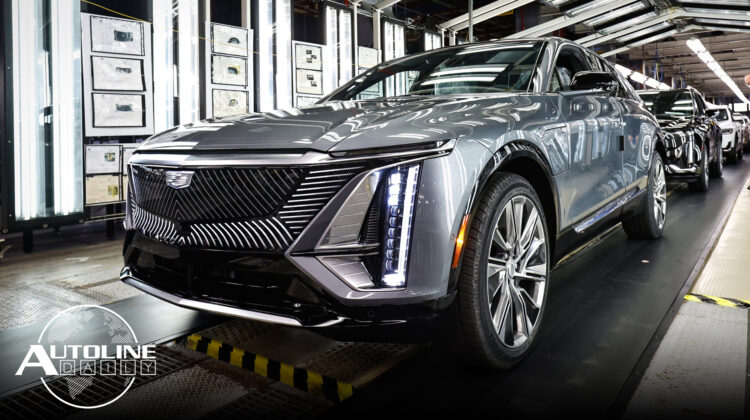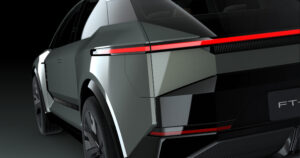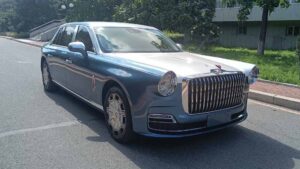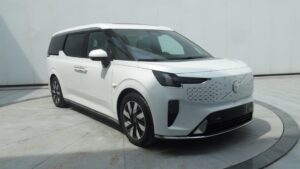
Follow us on social media:
Runtime: 8:49
0:00 UAW A Threat to D3 EV Investments
0:42 GM Canadian Workers Ratify New Deal
1:24 UAW’s Shawn Fain Shows Solidarity with EU Unions
2:23 GM’s Cruise Expands Its Business
3:39 Toyota Unveils Electric Concepts
4:48 California Mandates Electric School Buses
5:23 Hongqi’s $680,000 Limousine
6:20 First Look at Volvo’s Electric Minivan
7:10 Ferrari Now Accepting Crypto for Car Payments
Visit our sponsors to thank them for their support of Autoline Daily: Bridgestone, Intrepid Control Systems and Schaeffler.
This is Autoline Daily, the show dedicated to enthusiasts of the global automotive industry.
UAW A THREAT TO D3 EV INVESTMENTS
Day 32 of the UAW strike and it looks like the automakers are in no mood to concede anything more to the union. JP Morgan estimates that Ford is losing $44 million a day, while GM is losing $21 million a day. Even so, the automakers worry that the union is trying to force them into a bad deal that will leave them uncompetitive in the marketplace. Morgan Stanley says a new contract could force the automakers to cut back on their capital spending and delay their EV programs.
GM CANADIAN WORKERS RATIFY NEW DEAL
In contrast to the UAW’s approach, the Canadian union Unifor is getting the results it wants without all the bitterness. Even though it took a brief strike that only lasted hours, GM workers in Canada overwhelmingly approved a new contract that includes 20% raises, a transition to top pay in four years instead of eight years for new employees, plus fully defined pensions and COLA. Unifor has settled with GM and Ford and will now negotiate with Stellantis. And the Canadians will likely have a contract with all three automakers before the UAW even gets one done.
UAW’S SHAWN FAIN SHOWS SOLIDARITY WITH EU UNIONS
Meanwhile, Shawn Fain is generating solidarity with other unions from Europe. Here’s what he said in his latest video.
“I want to acknowledge our international union family who have made the long trip to the United States to stand in solidarity and stand up with our members. Leaders from FIOM, the largest industrial union in Italy, came here. I’m wearing their hoodie today. They were joined by our union family from Unite, the powerhouse UK union. Also attending were leaders from IndustriALL, the global labor federation that we all belong to. Our fight is not just about us, it’s about the working class. Our companies exploit workers across borders. It’s our job to unite and organize across borders as well.”
While Fain is talking about working with European unions, we wonder if he’ll reach out to unions in Mexico as well?
OK, let’s move past our union coverage.
GM’S CRUISE EXPANDS ITS BUSINESS
GM’s autonomous division, Cruise, is expanding its business. It’s now offering rides to the public in Houston for its driverless service. And the company says it updated its vehicles to improve interactions with emergency vehicles and first responders, after several incidents. By working with the police, EMS and fire officials, Cruise’s vehicles can better recognize an emergency situation, exit a scene more quickly and have improved emergency vehicle prediction behavior. Cruise has also made it so first responders can move the vehicle manually if they need to.
TOYOTA UNVEILS ELECTRIC CONCEPTS
Toyota has started putting a lot more effort into EVs and it will use the Japan Mobility Show at the end month to reveal a couple of concepts that hint at its electric future. The FT-3e is an SUV that looks like it could have a similar shape to the Jaguar I-Pace and display the charge level and interior temp and air quality on a long band that stretches across the lower part of the front doors. And the FT-Se is a sports car that is meant to have a more immersive driving experience with several display screens mounted around the rectangle steering wheel. Toyota recently showed how it’s going to take a more modular approach to vehicle manufacturing and despite the big differences in these concepts, they’ll share major components with each other. It also says it wants these cars to continue to grow with the driver through software updates as well as offer convenience functions that sound like different levels of ADAS and hands-free driving. We’ll learn more when the Japan Mobility Show kicks off on October 26th.
CALIFORNIA MANDATES ELECTRIC SCHOOL BUSES
California has already mandated that all new car sales must be electric by 2035 and now it’s mandating that all new school buses must also be electric by the same time. The state estimates that it will cost $5 billion to make the transition but school districts will save money in the long term from not having to spend money on fuel and they can also earn money with bi-directional charging. California is the fifth state to mandate electric school buses joining Connecticut, Maine, Maryland and New York.
HONGQI’S $680,000 LIMOUSINE
Chinese automaker Hongqi, which is the high-end luxury brand of state-owned FAW, just got approval for the newest version of its L5 sedan. Not much has changed from the all-new model that came out in 2014, other than a bigger grille and a two-tone paint job, but with an intended target of high-ranking Chinese officials and the ultra-wealthy, the L5 has some impressive stats that are hard to pass up. It’s over 19.5 feet or nearly 6 meters long, which is more than 16 inches longer than a Maybach, it weighs 3,150 kilograms or about 7,000 pounds and features a roughly 390 horsepower 4.0L V8 engine. A price tag of 5,000,000 yuan or $680,000 is just as impressive as its size.
FIRST LOOK AT VOLVO’S ELECTRIC MINIVAN
Thanks to the Chinese Ministry of Industry and Information Technology and CarNewsChina we’re getting our first look at Volvo’s first minivan, the EM90. It’s an all-electric model that’s based on the same platform as the Zeekr 009, which comes from parent company Geely. It’s nearly the exact same size as the current Chrysler Pacifica minivan. A single 272 horsepower electric motor will drive the rear wheels and it will feature an NMC or nickel, manganese, cobalt battery pack from CATL. But its capacity is unknown at this time. We suspect there will also be several other variants of the EM90, including with AWD. But that’s all the detail we have for now.
FERRARI NOW ACCEPTING CRYPTO FOR CAR PAYMENTS
You can now buy a Ferrari with crypto. The automaker’s head of marketing told Reuters that it is now accepting cryptocurrency as payment for its cars in the U.S. and it will start doing the same in Europe in the first quarter of next year. It will eventually extend to other markets where it is legally accepted as well. Ferrari says it made the decision because of requests from customers and dealers. And it makes sense because there are a lot of cryto millionaires out there. As you may remember, Tesla began to accept payments in bitcoin in 2021 but Elon Musk put a stop to it over environmental concerns because of all the electric energy that’s needed for mining the currency.
And that brings us to the end of today’s show. Thanks for tuning in.
Thanks to our partner for embedding Autoline Daily on its website: WardsAuto.com









Shawn Fain made mention of “employers exploiting workers”. Perhaps my head has been in the sand as of late and I’m just out of the loop. But how exactly is it that workers who (on nothing more than a high school education) are already making close to and in some cases in excess of 6-figure incomes, with gold-plated health and disability insurance and very liberal PTO, qualify as having been exploited?
Am I out of place for finding it a tad difficult to sympathize with the autoworkers here?
I’d pass on the Hongqi limo, even for 1/10 the price. It’s really ugly, and would not drive very well.
I’m not sure Morgan Stanley knows how things work in the automotive industry, but this strike is not going to delay any EV programs. Development will continue by white collar jobs, and they will not allow current labor negotiations interfere with the stability of future business.
Mandate EV busses, but don’t offer a solution to how they’ll be paid for. The convenient part, of this for those states is it falls back to the local school district to figure it out. Sure, it might save money in the long run but that doesn’t help with the up-front costs. For those bus drivers that take their bus home do they get a charger installed? Is it metered separately from their home? They probably haven’t even thought about that.
It seems that the UAW leadership thinks it’s still 2007, and wants the defined pension and other benefits the workers had at that time. Most factory workers haven’t had the pension and health care benefits Fain wants in decades, or ever.
According to this:
https://www.lasvegasbussales.com/what-factors-contribute-to-the-life-expectancy-of-a-school-bus/#:~:text=Twelve%20years%20is%20the%20average,that%20should%20be%20adhered%20to.
Average school bus lifetime is 12 years, so they wouldn’t need to be replacing them “early” to be buying only EVs be 2035. The EVs will cost more, but operating costs would be much lower, both from not needed oil changes, brakes lasting much longer, and lower fuel cost. There’d be the one time cost of installing charging infrastructure to charge them overnight, but if the buses are parked in a secure area, as many seem to be, the charging setup could be very simple. Sub metering would work for buses taken home.
The typical school bus is in service for 12 years. After that, federal money is given to replace them. Could the school keep them longer, of course, but most don’t as the federal government is buying a new one anyhow. The US seems to be the outlier here as the federal government is paying to replace them. Most other countries keep their school buses far longer at 30 years old in some cases. Twelve years though is a great time to get rid of an EV bus as the battery will likely be heading down hill quickly and would cost a ton of money to replace. Nobody is going to buy a used EV bus for RV use as is done today. Nobody will want to replace the batteries. So they will be scrapped every 12 years. So something as large as a school bus is completely disposable. The environment will weep a little more with that unintended consequence, but it won’t be the last unintended consequence with this EV switch.
Sticking to the USA however, the average school bus travels between 80 to 160 miles per day. It is a good use case for EVs. Of course those in cold climates will have to plan battery capacity to operate heaters and those in warmer climates will need capacity to operate air conditioners. The tricks passenger cars use to provide heat will not work in a bus, such as heated seats. So they are going to require power robbing bulk air heating/cooling systems. So it will be very large batteries which means very large expense up front. Is it offset by reduced maintenance and fuel costs? Probably not but this is the government and spending money wisely according to the principles of math never apply.
Then there is how schools make extra money with their bus fleets. They rent them out for various sports transportation and other organizations that pay to have their members transported. That is not going to happen anymore as the buses will be at home base charging. Of course there is also the school field trips for their own students and sports teams. Some of these trips are very far. For instance, Michigan to Washington DC for a special field trip for a student class project. All using school busses. Imagine how many stops and long times at each stop that trip would take. What a nightmare for the driver and teachers that are assigned to corral a couple hundred students at a Walmart charge point for hours. Imagine a school bus blocking all the Walmart chargers to charge 1 bus for hours since none are pull through. There will be “tension”.
I guess maybe California will find out soon enough about some of the draw backs to this concept. The right answer is, as always, a mix of technology. California is a state where they think everything is all or nothing and there possibly cannot ever be a compromise. None of this will help the environment but I am sure it makes the California governor feel better so that is something. And why not make the governor feel good, the federal government tax payers are ultimately footing the bill anyhow. It isn’t their money so they might as well go heavy on the expenses.
Merkur, where are you seeing that the federal government buys everyone new school buses every 12 years? I’m not finding it.
As far as California, they can buy new diesel buses until 2035. They can buy enough of them in 2034 to cover the field trips, sports team trips, etc. Since they will last 30 years, if properly maintained, they will have until 2064 to sort things out. A lot will change by then, and decisions can be made about what will work best.
As far as cabin heat in the buses, much of California won’t need much cabin heat. Also, aren’t the kids going to be dressed for the outside weather on any given day? When I rode a school bus, they barely had cabin hear, so if it was zero out, you dressed warmly, both for the wait for the bus, and the ride in the cold bus. An option would be a gasoline heater like used in VW Beetles and Corvairs. No, that probably wouldn’t be within the spirit of the electric buses.
I could be wrong but I believe there was a law passed that only allowed school busses to be in service for 12 years. This was an effort to get old engine tech off the road and the newer busses had improved passenger safety. Some states like NJ just passed a law extending that to 15 years for busses manufactured after 2007 that have closed crankcase tech. So I’m not really sure if they can keep busses on the road for even 20 years with even stellar maintenance.
Merkur brings up a good point that even with a brand-new EV bus the field trips and some sporting events will be out of reach. Which will leave schools with few options. Charter a bus or plan for a much longer commute. I know when our school would make it to Reginals or state finals those games could be halfway across the state. The team/band/cheer will have to skip school and leave in the morning to make it in time. Cali will soon learn these lessons.
Pleased to see the union and OEMs are taking a different track in Canada. The world just doesn’t need everybody to be angry at each other all the time.
Did I hear that right? Elon thinks that the amount of energy to mine coins is bad but the tons of materials mined for his electric cars is ok. You can’t make this stuff up!
Who is going to make the electric school buses, maybe Proterra Inc. Oh that’s right I forgot they filed for bankruptcy after taking millions in government support to build electric buses.
Another day of the Electric Revolution… meanwhile those MachE’s keep collecting dust on the lot here.
Lambo, as I said, they can buy non-ev buses in CA until 2035. Buy enough of them for the sports teams and field trips. They could even buy a few nice buses for that, and keep them a long time.
Joe G., according to this, Bitcoin alone emits as much CO2 as all US railroads.
https://rmi.org/cryptocurrencys-energy-consumption-problem/#:~:text=Bitcoin%20alone%20is%20estimated%20to,fuel%20used%20by%20US%20railroads.
Apparently the computers to make that “cryptocurrency” use a lot of alectricity. Mining is dirty, and some of it is energy intensive, especially extracting and processing tar sands oil. It’s hard to find real data on environmental impact of EVs, tgough. There’s a lot of conflicting stuff out there.
The ability to edit seems to be gone.
Yes! Kit I fully understood what you said. However, if there is a law preventing school busses from being in service for more than 12 or 15 years then that new bus, they buy in 2035 will only get them to 2050 not 2064 like you mentioned. Honestly, it’s all a moot point as I would have to believe the battery tech and or charging structure will either be in place by that time or EVs will have died or something else has evolved to provide propulsion.
The other good thing is they don’t actually have to even start buying EV busses until 2035. So, with a 15 year life span the ICE busses won’t be phased out until 2050. They essentially have those 15 years to replace the fleet a few busses each year.
Yeah the edit function was gone yesterday but its back today.
Interesting;https://www.msn.com/en-us/money/companies/ford-is-laying-off-about-700-workers-from-detroit-plant-that-builds-f-150-lightning-due-to-supply-chain-constraints-and-sales-falling-45-percent-not-the-ongoing-uaw-strikes/ar-AA1ijI1y?ocid=hpmsn&cvid=c4e68845397b4fc7b4b4fc8e04348da9&ei=61
Guess the lightning isnt selling so well. Not surprised.
As Sean mentioned in the bus segment, “they can also earn money with bi-directional charging”. I forget the exact amount, but I think last time he said something crazy high, like $10K per bus, per year. That should be enough incentive right there. School busses are the perfect application for EVs, they will just have to find ways to get around those outlying situations. Maybe the parents will have to transport their own kids to regionals, or rent a bus once a year with all the money they make from bi-directional charging.
The consensus here on the Hongqi limo is that it looks cool, but the name sounds a little suspect. Maybe honky is just the sound of the horn.
Yes, the editing is back today.
Ukendoit; I really believe the return on selling back electric has been way over-inflated. Anyone with solar panels can tell you that they average making $120-$150 a year selling back electricity. They power their home for free and that normal monthly bill was @ $150 X12 = $1800 plus the 150. So, if they are including the usage and profit it’s still only just shy of $2000. A far cry from 10k. I wouldn’t expect an EV to be any better than that. I think it’s an EV selling scam, and until someone with an actual EV shows me how they made 10K a year selling back juice I’m going to assume it can’t be done. EV owners will most likely be happy if they just break even. Besides the bus needs to be fully charged and ready to go first thing in the morning so that sell back window is going to be small.
Ukendoit, I work with a school robotics team, and we hire charter buses for longer trips, like 500 miles, but short enough that we don’t fly. School buses are used for shorter trips, like 50-75 miles. Things have gotten more complicated regarding non-parents transporting kids to school related events in their private or rental vehicles, but with the proper paperwork, it can be done.
I’m skeptical about selling power back to the utility from vehicle batteries, because doing it is going to shorten the battery life. The number of charge-discharge cycles is a big determining factor in battery lifetime.
Wow, the automotive industry is buzzing with exciting updates! The UAW’s impact on D3 EV investments is a hot topic, especially with GM Canadian workers ratifying a new deal. Shawn Fain’s solidarity with EU unions adds an interesting global perspective. Toyota’s electric concepts and California’s mandate for electric school buses show a strong push towards sustainable transportation. The $680,000 Hongqi limousine and Ferrari accepting crypto for payments add a touch of luxury and modernity. On another note, as EV adoption rises, the importance of EV charger installation cannot be overstated. It’s a key factor in facilitating widespread electric vehicle use and ensuring a greener future.